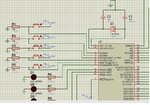Cristinuk
Newbie level 3
I'm trying to control a dc motor(12 V) with two relays by using PWM. I've made the program(in MicroCfor PIC,because I'm using a PIC16F877A microcontroller) and the simulation in ISIS Proteus.
I have a problem, the motor doesn't run continously,it stops,then it starts again. I think it's something with PIC's frequency but I can't find the problem.
I've set the PWM frequency at 300 Hz...if I put it bigger,it doesn't work at all.The external crystal is set at 4 MHz.
I've attached also a picture with the simulation.
Here's the code:


I have a problem, the motor doesn't run continously,it stops,then it starts again. I think it's something with PIC's frequency but I can't find the problem.
I've set the PWM frequency at 300 Hz...if I put it bigger,it doesn't work at all.The external crystal is set at 4 MHz.
I've attached also a picture with the simulation.
Here's the code:
Code C - [expand]


Last edited by a moderator:

